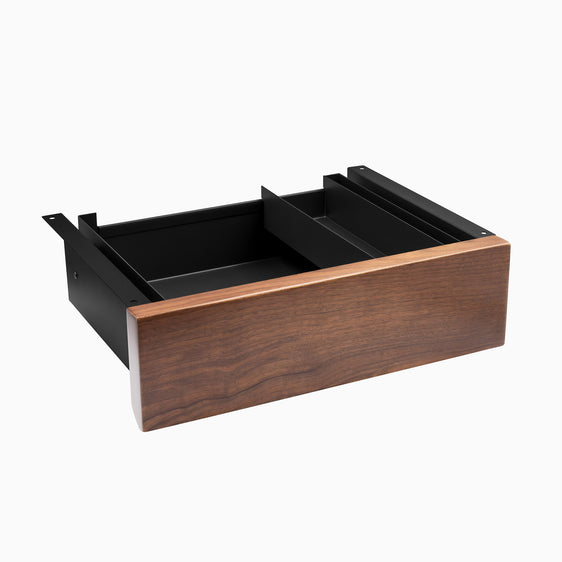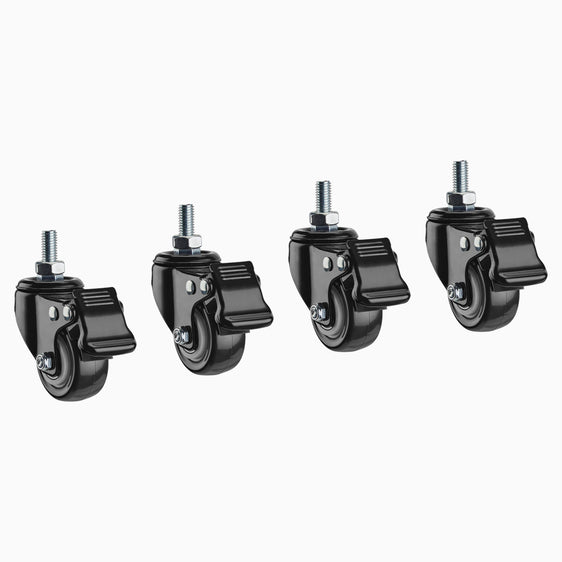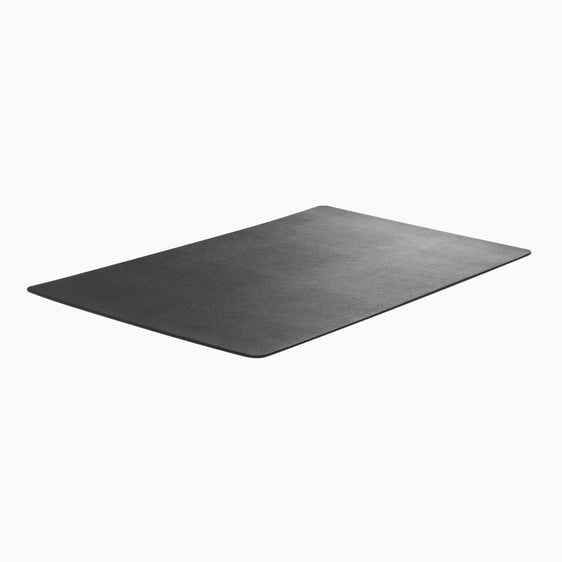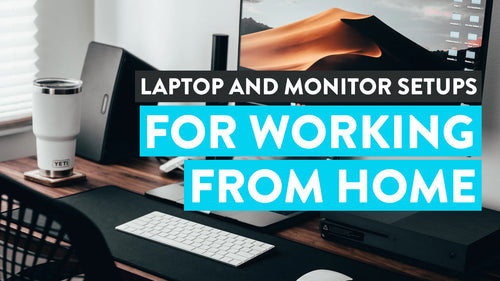
Nouvelles
Courbé contre. Écran plat : quel est le meilleur pour le travail ?
Hayden AdamsChoisir le bon moniteur pour le travail peut être difficile. Comme si l'abondance de moniteurs sur le marché ne suffisait pas à nous laisser perplexes, l'ajout de moniteurs incurvés sur le marché a rendu le choix encore plus difficile.
Alors, quelle est la différence entre un écran plat et un écran incurvé, et quel est le meilleur pour vous ? Dans cet article, nous explorerons les différences entre les moniteurs incurvés et plats et vous guiderons dans le choix du moniteur qui vous convient le mieux.
Les différences entre ces deux configurations peuvent certes être assez déroutantes, c'est pourquoi dans cet article, nous explorerons les différents facteurs que vous devez prendre en compte avant de décider d'opter pour un moniteur plat ou incurvé pour votre configuration de travail.
Différence entre les configurations de moniteur incurvé et plat

Pour les jeux, nous avons soif d’expériences immersives qui nous transportent entièrement dans des mondes virtuels. Mais cela n’est peut-être pas idéal pour tout le monde au travail. Cela dit, notre vie professionnelle nous oblige de plus en plus à utiliser plusieurs moniteurs , et pour les personnes travaillant dans les industries créatives, la frontière entre ce qui fonctionne pour le travail et les loisirs peut être encore plus floue. Et si vous utilisez votre ordinateur personnel pour le travail, vous souhaiterez peut-être l'utiliser à des fins récréatives en dehors des heures de travail.
Alors, lequel choisir ? À première vue, la seule différence apparente entre les écrans incurvés et les moniteurs plats réside dans la conception de l’écran. Cependant, en y regardant de plus près, on découvre plusieurs facteurs qui les distinguent. Bien sûr, sur le papier, la qualité des couleurs, la dalle IPS, la résolution, les taux de rafraîchissement et de réponse sont relativement similaires sur les moniteurs incurvés et plats. Et vous ne manquerez aucune fonctionnalité importante lorsque vous optez pour un moniteur incurvé ou plat pour le travail de bureau. Néanmoins, il existe certaines caractéristiques propres à chaque type de moniteur qui peuvent en rendre un plus adapté à une application spécifique que l'autre. Examinons les différences entre les panneaux incurvés et les moniteurs plats.
Lesquelles ont la meilleure qualité de couleur ?
Les moniteurs plats et incurvés diffèrent par la qualité et la gamme de couleurs qu'ils peuvent afficher. Les moniteurs incurvés surpassent généralement les écrans plats, car chaque pixel de l'écran incurvé est parfaitement orienté vers l'œil.
Les couleurs sur un écran plat peuvent se déformer à mesure qu'elles s'éloignent de l'œil, ce qui entraîne des variations de couleur plus importantes en fonction de l'angle. Cela peut les rendre peu fiables à certaines fins. Les moniteurs adoptent de plus en plus le HDR pour sa luminance de haute qualité, ses blancs éclatants et ses noirs profonds, et de nombreux moniteurs plats proposent également le HDR, ce qui atténue dans une certaine mesure ce problème.
Lequel a le taux de rafraîchissement le plus élevé ?
Il existe une vaste gamme de taux de rafraîchissement différents en fonction du modèle et du prix, et selon que vous choisissez un écran entièrement incurvé ou un écran plat. Les options vont du standard de 60 Hz trouvé dans les moniteurs économiques, jusqu'à des taux de rafraîchissement de 240 Hz ou même plus pour les modèles incurvés les plus chers. Compte tenu de leur plus grande taille, les moniteurs incurvés avec des taux de rafraîchissement similaires seraient plus chers que leurs homologues à écran plat.
Ne vous inquiétez pas si le budget est serré, car lorsqu'il s'agit d'objectifs professionnels, le taux de rafraîchissement n'est pas aussi crucial que pour les jeux et les tâches qui nécessitent des réponses rapides aux changements de couleur et aux mouvements. Par conséquent, pour la majorité des emplois et des tâches, le taux de rafraîchissement pose moins de problèmes.
Les moniteurs incurvés sont-ils plus grands ?

Comme ils sont plus larges et ont des dimensions plus complexes, la quantité de matériau utilisée pour produire un moniteur incurvé est plus élevée et, par conséquent, les moniteurs incurvés sont généralement plus grands que les moniteurs à écran plat. La plus grande taille des écrans plats, destinée à impliquer la vision périphérique de l'utilisateur, ajoute à ce problème. En effet, cela signifie qu'un moniteur incurvé occupera dans la plupart des cas plus d'espace sur le bureau qu'un moniteur à écran plat de même taille d'écran.
Utilisation de l'espace
En matière d'utilisation de l'espace, les écrans plats présentent un avantage. Leur conception permet une intégration plus facile dans diverses configurations, telles qu'un montage mural ou une installation dans des postes de travail compacts . Les écrans plats occupent moins d’espace sur le bureau et offrent plus de flexibilité en termes de placement et de disposition.
Quels sont les moniteurs les plus lourds, plats ou incurvés ?
À mesure que la largeur et la taille du moniteur de jeu incurvé augmentent, son poids augmente également. En tant que tels, les moniteurs incurvés ont tendance à être plus lourds que les moniteurs à écran plat. En raison de leur plus grande taille, les moniteurs de jeu incurvés peuvent également nécessiter un bureau plus grand ou une station de jeu dédiée pour les accueillir correctement. Cela vaut la peine d'être conscient si vous utilisez un bureau debout , car vous devrez vous assurer que vos moteurs peuvent supporter le poids supplémentaire !
{{ spec_dual_hardwood_desk }}Les moniteurs incurvés sont-ils plus chers ?
Les moniteurs incurvés sont généralement plus chers que les moniteurs plats, simplement parce qu'ils sont plus grands. Étant donné que la plupart des moniteurs incurvés sont plus grands, ils utilisent plus de matériaux et ont également tendance à être globalement plus chers.
Distance de visualisation idéale
Lorsque l’on compare les écrans incurvés et les moniteurs plats, la distance de visualisation reste relativement inchangée. Les écrans incurvés utilisent la courbure de l'écran pour imiter la vision humaine, créant une illusion de distance et de profondeur. Les écrans plats n'ont pas cette profondeur naturelle ici, et pour la plupart des moniteurs incurvés, ils offrent une expérience visuelle plus confortable et immersive une fois que vous vous y êtes habitué.
Ainsi, même si vous êtes assis à la même distance de l’écran, un écran incurvé s’aligne mieux sur le rayon de courbure du cône de vision, offrant ainsi une expérience visuelle plus confortable . Cela peut aider à réduire la fatigue oculaire et les affections associées.
Rapports d'écran
Le rapport d'écran diffère entre les moniteurs incurvés et plats. Les moniteurs incurvés ont souvent un rapport d'écran de 21:9, ce qui signifie que la largeur est 2,3 fois supérieure à la hauteur. Un rapport d'écran plus élevé se traduit par un champ de vision plus large, ce qui est particulièrement souhaitable pour les joueurs. D'un autre côté, les écrans plats ont un rapport hauteur/largeur moindre et un champ de vision plus étroit, ce qui peut être préférable pour taper, lire et se concentrer sur les détails de l'écran.
Qu'est-ce qu'un indice de courbure ?
La taille et les mesures de l'affichage diffèrent considérablement entre les moniteurs incurvés et les écrans plats. Les moniteurs incurvés sont évalués à l'aide de mesures telles que 1000R ou 1800R, où la lettre « R » représente le rayon et le chiffre qui la précède indique la mesure en millimètres. En revanche, les moniteurs à écran plat sont mesurés en diagonale sur le rectangle de l’écran entier lui-même.
Lequel a les meilleures qualités immersives ?
L’expérience immersive offerte par les moniteurs incurvés et plats diffère considérablement. Les moniteurs incurvés créent l’illusion de marges d’affichage plus grandes qu’elles ne l’ont réellement. De plus, les technologies d'écran partagé 2.0 permettent de diviser les moniteurs incurvés en plusieurs fenêtres gérables, améliorant ainsi l'effet immersif des modèles incurvés.
La courbure de ces moniteurs offre une expérience plus immersive en « remplissant » la vision périphérique de l'utilisateur, lui permettant ainsi de se sentir pleinement impliqué dans le contenu affiché, qu'il s'agisse d'un jeu ou de toute autre application, et peut être excellente pour le travail visuel.
Les moniteurs incurvés sont-ils meilleurs pour le confort oculaire ? 
Nos yeux perçoivent naturellement le monde de manière courbée – cela est dû à notre vision périphérique ou aux choses que nous voyons dans le coin de notre œil. Les écrans incurvés sont conçus pour maximiser le champ de vision lorsque vous travaillez, minimiser les mouvements oculaires et réduire ainsi la fatigue oculaire. De nombreuses études, dont cette étude de 2023, ont montré que les écrans incurvés sont nettement plus confortables pour les yeux que les dispositions côte à côte d'écrans plats.
Prévenir l'éblouissement de l'écran
Un placement correct des moniteurs à écran plat dans votre maison ou votre lieu de travail est crucial car ils sont plus sensibles à l'éblouissement. Les moniteurs incurvés ont tendance à être moins affectés par l'éblouissement en raison de leur conception incurvée, car la courbure contribue à réduire les reflets et à minimiser l'impact des sources de lumière externes. Les moniteurs incurvés prennent tout leur sens dans des environnements lumineux et bien éclairés, dans des environnements dotés d'un éclairage intense ou de nombreuses fenêtres. Si vous utilisez des moniteurs à écran plat, faites attention à votre emplacement, car ils vous éblouiront s'ils sont placés en lumière directe.
Lequel a la meilleure esthétique ?
L'attrait esthétique des moniteurs incurvés et plats est subjectif et dépend des préférences personnelles. Les moniteurs incurvés ont souvent un look plus élégant et plus moderne qui peut améliorer l'attrait visuel global d'un espace de travail et séduirait les entreprises ayant une philosophie et une esthétique plus modernes. Les moniteurs plats, quant à eux, ont une apparence presque classique qui se marie bien avec différents environnements.
Écrans incurvés et plats pour les configurations multi-écrans
Monter un écran d'ordinateur incurvé sur un bureau peut s'avérer difficile en raison de sa courbure. Un espace limité peut rendre difficile le positionnement ergonomique de vos écrans , surtout si plusieurs moniteurs sont impliqués. Installer deux moniteurs incurvés côte à côte peut être particulièrement difficile. En revanche, les écrans plats sont plus simples à fixer et à aligner. Les moniteurs incurvés nécessitent un centrage précis lorsqu'ils sont couplés, pour garantir que la courbure englobe efficacement l'ensemble du champ de vision du spectateur.
{{ spec_quad_arm }}Cela pourrait-il affecter mon matériel existant ?
Les pixels ont une taille définie et un nombre limité de pixels peuvent tenir sur un seul écran. À mesure que la largeur du moniteur augmente, le nombre de pixels affichés augmente également. Il est donc important de se rappeler que si vous envisagez de jouer à des jeux sur un panneau ultra-large, vous aurez besoin d'une carte graphique capable de gérer la sortie supplémentaire. Cela signifie que vous devrez peut-être mettre à niveau votre carte graphique pour prendre en charge la résolution souhaitée si vous choisissez un moniteur incurvé – assurez-vous de vérifier les spécifications matérielles avant d'acheter !
Compatibilité des appareils
La compatibilité avec d'autres appareils est évidemment une considération essentielle lors du choix des moniteurs – mais vous seriez surpris du peu de vérifications. Comme vous vous en doutez, les deux types de moniteurs offrent généralement une gamme de connexions, vous pouvez donc généralement miser sur une variété de ports HDMI, DisplayPort et USB . Il est crucial de s'assurer que le moniteur choisi dispose des ports nécessaires pour se connecter à vos appareils, il est donc important de revérifier.
Avantages et inconvénients des moniteurs incurvés et plats 
Examinons maintenant les avantages et les inconvénients des moniteurs incurvés et plats pour le travail. Les moniteurs incurvés ont attiré une attention particulière pour leurs fonctionnalités immersives et leur design unique. Ils offrent plusieurs avantages que l’on ne retrouve pas dans les écrans plats, mais de combien d’entre eux avez-vous réellement besoin au bureau ? Voici les avantages et les inconvénients de l’utilisation d’écrans incurvés pour le travail :
Avantages des moniteurs incurvés
- Immersion accrue : les moniteurs incurvés offrent une sensation d'immersion accrue, particulièrement bénéfique pour les concepteurs de jeux et les graphistes qui souhaitent se sentir pleinement engagés dans leur travail et ont besoin d'un large éventail de vision.
- Idéal pour le multitâche : l'écran ultra-large des moniteurs incurvés offre suffisamment d'espace pour plusieurs onglets et applications, éliminant ainsi le besoin d'un troisième moniteur ou d'une configuration multi-moniteurs .
- Adaptés au travail haute résolution : les moniteurs incurvés sont bien adaptés aux tâches qui nécessitent des visuels haute résolution, la plupart des tâches telles que le montage vidéo ou la conception graphique.
- Confort oculaire : La courbure du moniteur s'aligne sur la courbure naturelle de l'œil humain lui-même, réduisant ainsi la fatigue oculaire et offrant une expérience visuelle plus confortable, en particulier lors de longues sessions de travail.
Inconvénients des moniteurs incurvés
- Construction plus lourde : les moniteurs incurvés ont tendance à être plus lourds que leurs homologues plats en raison de leur conception plus large, nécessitant un support solide.
- Exigence de carte graphique : Pour utiliser pleinement les capacités d'un moniteur incurvé, une carte graphique compatible est nécessaire.
- Réglage initial : Il faudra peut-être un certain temps pour s'habituer à l'écran incurvé, surtout si vous êtes habitué aux écrans plats.
- Coût plus élevé : un écran incurvé est généralement plus cher que les options à écran plat, ce qui fait d'un seul moniteur un investissement important.
Les moniteurs à écran plat sont depuis longtemps un incontournable dans la plupart des lieux de travail. Ils sont privilégiés pour leur simplicité et leur polyvalence. Cependant, ceux qui recherchent une résolution couleur élevée peuvent toujours préférer les moniteurs incurvés. Examinons de plus près les avantages et les inconvénients de l'utilisation d'un écran plat pour le travail :
Avantages des moniteurs plats
- Légers et conviviaux : les moniteurs plats sont légers et faciles à manipuler, garantissant une configuration et une mobilité pratiques.
- Abordabilité : les moniteurs plats sont généralement plus économiques que les moniteurs incurvés.
- Adaptés aux tâches de base : ils sont bien adaptés aux exigences de travail simples sans avoir besoin de fonctionnalités avancées.
- Rapport d'aspect plus large : les moniteurs plats prennent en charge un rapport d'aspect plus large, créant une zone de visualisation horizontale étendue.
- Configurations multi-moniteurs : les écrans plats sont idéaux pour créer des configurations multi-moniteurs.
Inconvénients des moniteurs plats
- Expérience immersive limitée : contrairement aux moniteurs incurvés, les écrans plats n'offrent pas une expérience visuelle totalement immersive.
- Qualité d'image réduite sur les bords : La qualité de l'image près des bords d'un écran plat peut ne pas être aussi nette ou éclatante.
En fin de compte, la décision entre un moniteur incurvé ou plat dépendra du choix de chacun, ainsi que de ses besoins et préférences. Pour les joueurs et ceux qui recherchent une expérience de travail plus immersive, un moniteur incurvé avec un taux de rafraîchissement élevé et un rapport d’écran large peut être le choix idéal. D’un autre côté, pour les tâches liées au travail où les taux de rafraîchissement sont moins critiques, un écran plat peut offrir praticité, facilité d’installation et efficacité de l’espace.
Au moment de prendre votre décision, tenez compte de facteurs tels que le coût, les angles de vision, la distance, le rapport d’écran, la précision des couleurs, l’immersion, le confort oculaire et l’éblouissement de l’écran. Pour les configurations multi-écrans, pensez à l’utilisation de l’espace et enfin à l’esthétique. Et n'oubliez pas de vérifier la compatibilité ! Suivez simplement les conseils ci-dessus et vous devriez maintenant être en mesure de déterminer quel type de moniteur correspond le mieux à vos besoins.








